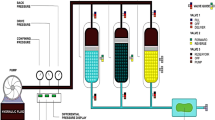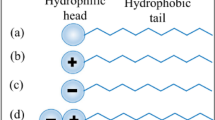Abstract
Sophorolipids (SLs) offer an “environmentally friendly” alternative to chemically produced surfactants currently used in formulations for crude oil extraction, processing, and reclamation. Studies herein describe how sophorolipid structure influences its interfacial properties for environmentally and industrially relevant oil–water systems where the oil phase is Arabian light crude oil, paraffin oil, decane, hexadecane, a 1:1 vol/vol mixture of o-xylene and 1,2-dimethylcyclohexane, or a mixture of paraffin oil, o-xylene, and 1,2-dimethylcyclohexane (synthetic crude oil). SL-hexyl ester (SL-HE) reduces the crude oil–water interfacial tension (IFT) by 57 and 91% at 0.001 and 0.5 mg/mL, respectively. Crude oil displacement tests reveal that SL-ethyl ester (SL-EE) and SL-HE contract a crude oil slick on water to about 20% of its starting volume allowing for easier burning of spilled crude oil on marine surfaces. Water retention and emulsion phase (e.g., o/w vs. w/o) are determined by SL-structure/concentration, oil concentration, and oil composition to understand their performance for crude oil transportation and clean-up. For the first time, w/o emulsions were obtained using SLs and their formation occurred after homogenization when the oil phase consisted of a 1:1 mixture of o-xylene and 1,2-dimethylcyclohexane. Generally, the performance of SL-esters in the above studies was superior to that using Triton X-100, a comparison nonionic surfactant. Hence, SL-esters offer a valuable platform for tuning interfacial properties to optimize surfactant performance.










Similar content being viewed by others
References
EIA (2015) Annual energy outlook 2015 with projections to 2040. US Energy Information Administration, Washington DC
Kark S, Brokovich E, Mazor T, Levin N (2015) Emerging conservation challenges and prospects in an era of offshore hydrocarbon exploration and exploitation. Conserv Biol 29:1573–1585
Kimes NE, Callaghan AV, Suflita JM, Morris PJ (2014) Microbial transformation of the Deepwater Horizon oil spill-past, present, and future perspectives. Front Microbiol 5:1–11
Sandifer PA, Trtanj JM, Collier TK (2013) A perspective on the history and evolution of an oceans and human health “metadiscipline” in the USA. Microb Ecol 65:880–888
Wasan D, McNamara J, Shah S, Sampath K, Aderangi N (1979) The role of coalescence phenomena and interfacial rheological properties in enhanced oil recovery: an overview. J Rheol 23:181–207
Mandal A, Samanta A, Bera A, Ojha K (2010) Role of oil-water emulsion in enhanced oil recovery. In: International conference on chemistry and chemical engineering (ICCCE 2010). doi:10.1109/ICCCENG.2010.5560393
Nour A, Mohd R, Anwaruddin Y, Anwaruddin H (2007) Water-in-crude oil emulsions: its stabilization and demulsification. J Appl Sci 22:3512–3517
Filho D, Ramalho J, Spinelli L, Lucas E (2012) Aging of water-in-crude oil emulsions: effect on water content, droplet size distribution, dynamic viscosity and stability. Colloids Surf A Physiochem Eng Asp 396:208–212
Sjöblom J, Aske N, Auflem I, Brandal Ø, Havre T, Saether Ø, Westvik A, Johnsen E, Kallevik H (2002) Our current understanding of water-in-crude oil emulsions. Recent characterization techniques and high pressure performance. Adv Colloid Interface Sci 100–102:399–473
Browarzik D, Rahimian H (1999) Asphaltene flocculation in crude oil systems. Fluid Phase Equilib 154:285–300
Eley D, Hey M, Symonds J (1988) Emulsions of water in asphaltene-containing oils droplet size distribution and emulsification rates. Colloids Surf 32:87–101
API (2011) Robust summary information on crude oil (CAS 8002-05-9). American Petroleum Institute, Washington, DC
Marti M, Colonna W, Patra P, Zhang H, Green C, Reznik G, Pynn M, Jarrell K, Nyman J, Somasundaran P, Glatz C, Lamsal B (2014) Production and characterization of microbial biosurfactants for potential use in oil-spill remediation. Enzyme Microb Technol 55:31–39
Pekdemir T, Çopur M, Urum K (2005) Emulsification of crude oil-water systems using biosurfactants. Process Saf Environ Prot 83:38–46
Takamura K, Loahardjo N, Winoto W, Bucklet J, Morrow N, Kuneida M, Liang Y, Matsuoka T (2012) Spreading and retraction of spilled crude oil on sea water. In: Younes M (ed) Crude oil exploration in the world. InTech, Rijeka
Buist I, Potter S, Nedwed T, Mullin J (2011) Herding surfactants to contract and thicken oil spills in pack ice for in situ burning. Cold Reg Sci Technol 67:3–23
Azam F, Fenchel T, Field J, Gray J, Mayer-Reil L, Thingstad F (1983) The ecological role of water-column microbes in the sea. Mar Ecol Prog Ser 10:257–263
Sathishkumar M, Binupriya A, Baik S, Yun S (2008) Biodegradation of crude oil by individual bacterial strains and a mixed bacterial consortium isolated from hydrocarbon contaminated areas. Clean 1:92–96
Lechuga M, Fernández-Serrano M, Jurado E, Núñez-Olea J, Ríos F (2016) Acute toxicity of anionic and non-ionic surfactants to aquatic organisms. Ecotoxicol Environ Saf 125:1–8
Bamberger M, Oswald R (2012) Impacts on gas drilling on human and animal health. New Solut 22:51–77
DiGuilio D, Jackson R (2016) Impact to underground sources of drinking water and domestic wells from production well stimulation and completion practices in the Pavillion, Wyoming. Field Environ Sci Technol 50:4524–4536
Cameotra S, Makkar R (2010) Biosurfactant-enhanced bioremediation of hydrophobic pollutants. Pure Appl Chem 82:97–116
Silva R, Almeida D, Rufino R, Luna J, Santos V, Sarubbo L (2014) Applications of biosurfactants in the petroleum industry and the remediation of oil spills. Int J Mol Sci 15:12523–12542
Bognolo G (1999) Biosurfactants as emulsifying agents for hydrocarbons. Colloids Surf A 152:41–52
Marchant R, Banat I (2012) Microbial biosurfactants: challenges and opportunities for future exploitation. Trends Biotechnol 30:558–565
Van Bogaert I, Saerens K, Muynck CD, Develter D, Soetaert U, Vandamme EJ (2007) Microbial production of application of sophorolipids. Appl Microbiol Biotech 76:23–34
Bisht K, Gross R, Kaplan D (1999) Enzyme-mediated regioselective acylations of sophorolipids. J Org Chem 63:780–789
Hirata Y, Ryu M, Oda Y, Igarashi K, Nagatsuka A, Furuta T, Suguira M (2009) Novel characteristics of sophorolipids, yeast glycolipid biosurfactants, as biodegradable low-foaming surfactants. J Biosci Bioeng 108:142–146
Daverey A, Pakshirajan K (2010) Sophorolipids from Candida bombicola using mixed hydrophilic substrates: production, purification and characterization. Colloids Surf B 79:246–253
Ma X, Li H, Song X (2012) Surface and biological activity of sophorolipid molecules produced by Wickerhamiella domercqiae var. sophorolipid CGMCC 1576. J Colloid Interface Sci 376:165–172
El-Sheshtawy H, Aiad I, Osman M, Abo-Elsnar A, Kobisy A (2015) Production of biosurfactants by Bacillus licheniformis and Candida albicans for application in microbial enhanced oil recovery. Egypt J Petrol. doi:10.1016/j.ejpe.2015.07.018
Cooper D, Paddock A (1984) Production of a biosurfactant from Torulopsis bombicola. Appl Environ Microbiol 47:173–176
Koh A, Linhardt R, Gross R (2016) Effect of sophorolipid n-alkyl ester chain length on its interfacial properties at the almond oil-water interface. Langmuir 32:5562–5572. doi:10.1021/acs.langmuir.6b01008
Zaki N (1997) Surfactant stabilized crude oil-in-water emulsions for pipeline transportation of viscous crude oils. Colloids Surf A Physiochem Eng Asp 25:19–25
Oebius H (1999) Physical properties and processes that influence the clean up of oil spills in the marine environment. Spill Sci Technol 5:177–289
Peng Y, Totsingan F, Meier MAR, Steinmann M, Wurm F, Koh A, Gross RA (2015) Sophorolipids: expanding structural diversity by ring-opening cross-metathesis. Eur J Lipid Sci Technol 117(735):217–228
Ratsep P, Shah V (2009) Identification and quantification of sophorolipid analogs using ultra-fast liquid chromatography–mass spectrometry. J Microbiol Methods 78:354–356
Bisht K, Gross R, Kaplan D (1999) Enzyme-mediated regioselective acylations of sophorolipids. J Org Chem 63:780–789
Ward AFH, Tordai L (1946) Time-dependence of boundary tensions of solutions I. The role of diffusion time-effects. J Chem Phys 14:453–461
Campanelli J, Wang X (1999) Dynamic interfacial tension of surfactant mixtures at liquid-liquid interfaces. J Colloid Interface Sci 213:340–351
Thompson DG, Taylor AS, Graham DE (1985) Emulsification and demulsification relation to crude oil production. Colloids Surf 15:175–189
Abismaïl B, Canselier JP, Wilhelm AM, Delmas H, Gourdon C (1999) Emulsification by ultrasound: drop size distribution and stability. Ultrason Sonochem 6:75–83
Petrache H, Zemb T, Belloni L, Parsegian V (2006) Salt screening and specific ion adsorption determine neutral-lipid membrane interactions. PNAS 103:7982–7987
Beunen J, Ruckenstein E (1982) The effect of salting out and micellization on interfacial tension. Adv Colloid Interface Sci 16:201–231
Zhang Y, Cremer P (2006) Interactions between macromolecules and ions: the Hofmeister series. Curr Opin Chem Biol 10:658–663
Griffin W (1949) Classification of surface-active agents by HLB. J Soc Cosmet Chem 1:311–326
Triton X-100 surfactant technical data sheet. The Dow Chemical Company, Midland
Crude oil—physical and chemical data. International Agency for Research on Cancer, World Health Organization, Lyon
Koh A, Gross R (2016) Molecular editing of sophorolipids by esterification of lipid moieties: effects on interfacial properties at paraffin and synthetic crude oil-water interfaces. Colloids Surf A Physiochem Eng Asp 507:170–181
Acknowledgements
The authors are grateful for funding received from the National Science Foundation Partnerships for International Research and Education (PIRE) Program (Award #1243313).
Author information
Authors and Affiliations
Corresponding author
Electronic supplementary material
Below is the link to the electronic supplementary material.
About this article
Cite this article
Koh, A., Wong, A., Quinteros, A. et al. Influence of Sophorolipid Structure on Interfacial Properties of Aqueous-Arabian Light Crude and Related Constituent Emulsions. J Am Oil Chem Soc 94, 107–119 (2017). https://doi.org/10.1007/s11746-016-2913-7
Received:
Revised:
Accepted:
Published:
Issue Date:
DOI: https://doi.org/10.1007/s11746-016-2913-7




